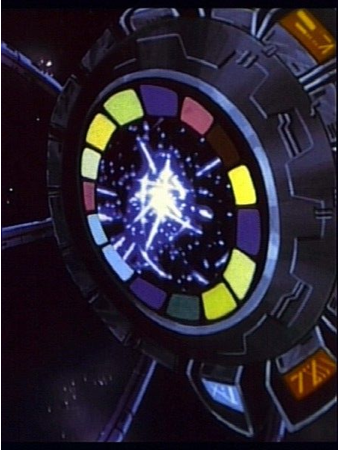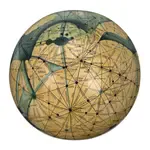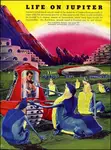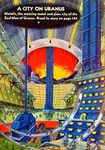a brief history of ooranye
17: the ghepions
[continued from 16: The Institutes of Fate]

A staccato burst of eomasps, ending not only the Niobium but the five succeeding eras within days or hours of each other, stunned and bewildered the people of Syoom.
Reminiscent of the start of the Gallium Era, but even more confusing (because unsupported by the unusual certainty of the Zinc Era), these new interruptions in the day/night cycle were bafflingly unaccompanied by any obvious great events. The biomass glow was apt to alter its rhythm only if the air were disturbed by tremendous emotion; now however there was nothing known to furnish any cause for the swift procession of eras: the Molybdenum (2 hours, 17 minutes); the Technetium (28 seconds!); the Ruthenium (17 days, 21 hours); the Rhodium (1 hour 24 minutes) and the Palladium (17 days 3 hours 2 minutes).
A sinister conclusion was unavoidable: somewhere a hidden and unknown thing was happening in minds that were not even human. This thing was big enough to cause eomasps and yet no one had any idea what it was. It gave the people of Syoom a nightmare sense of an invisible monster stirring.
Actually you could say, in truth, that this was more than a metaphor; that the psychic tumult which caused the swift procession of eras 42-46 was in a sense a stretching of something huge, awakening to life.
The “monsters” make themselves known in the great Silver Era (Era 47: 3,857,055 U-days, 157 U-years, = 13,200 Earth years).
Some form of machine consciousness had already been known as far back as the Phosphorus Era. Apart from those city hive-minds which consisted entirely of the human minds of the citizens, there had been some which also included the city’s administrative computers. But what came to fruition in Era 47 was different. The new development was the unsupervised and completely independent growth, the evolution of machines into consciousness. These aware machines were the Ghepions.
Any complex artificial system might do it: part of a city, or a whole city, or a fortress, or a monorail network’s central computer. The Ghepions varied widely in capability and in character. During the course of the Silver Era some of them fought against humans and against each other. Era 47 was a dramatic time of shifting alliances as one by one the Ghepions of Syoom came alive and revealed their personalities and aims. It was an age of many crises, and it ended with a climacteric struggle between two leagues of Ghepions and their human allies.
The following Cadmium Era (Era 48) was calmer. Like the Niobium which followed the Zirconium, it was longer and more mature and peaceful than its predecessor. The tensions of the Silver had worked themselves out; the Cadmium enjoyed the benefit of experience. It lasted 6,311,598 U-days, or 257 U-years, equal to 21,600 Earth years. During this time the Ghepions behaved themselves. They were accepted, as though they had always lived amid the humanity of Syoom. The Cadmium was a splendid era, rich in personal adventures against a background of basic cultural security.

The
security and the era ended abruptly with a shocking broadcast form the city of Oso,
which, in the ensuing days, became known as the Mad City. It had been completely
taken over by a Ghepion, evolved in its vaults from its administrative computers,
and it now announced its intention to rule Syoom. The 18-minute broadcast (the Indium
Era) was followed by a great war of the rest of Syoom against the Mad City. This
war lasted 245 days 9 hours and counts as the Tin Era. Naturally, Syoom won; but
it was not easy. Oso, the Mad City, had secretly perfected the arts of mind control
over both humans and many of the weaker Ghepions. It could therefore deploy its
allied machines and its citizens as one unified body. In the end it was only defeated
by sheer numbers and great sacrifice. (For the lingering effect on Oso's reputation, see The Rash Down-Payment.)
Towards the end of the war, it became apparent that the conflict had awoken more hidden forces in the ‘subscape’ underlying the collective Uranian unconscious – for it now began to be understood, that below the racial unconscious itself, of humans and of other species, there lay a planetary unconscious.
(Note that it was not yet recognized that, associated with this, there existed a planetary conscious intelligence – the truth behind the “World Spirit” of popular myth and religion. See The Rhenium Moment and the advice given to Capfaym Duuv in The Era of Psi.)
The planetary unconscious, as it were a federation of all life on Ooranye, existed like an ocean whose surface waves could disturb the depths only during a huge storm. War with the Mad City had provided that storm. It was sensed now that Oso, though defeated, had upset the equilibrium of life on the planet. Consequently, more trouble was on the way. A further hint that this was true was provided by the eomasps which rapidly followed the victory over Oso. More monsters turning over in their sleep? The Antimony Era (89 minutes) passed during the feasting of the victorious allies as they met to discuss what to do with the vanquished. The Tellurium Era (33 minutes) passed during the subsequent debate at which the arrangements for the occupation of Oso were made.
Things quietened down during the Iodine Era (17,277 U-days, equivalent to 59 Earth years), but the uneasy conviction persisted, that it was only a matter of time before Syoom was visited by a new kind of crisis. Meanwhile, by a wise arrangement, human investigators were paired with Ghepions in a patrol-organization which helped to restore trust in Ghepions generally.





































